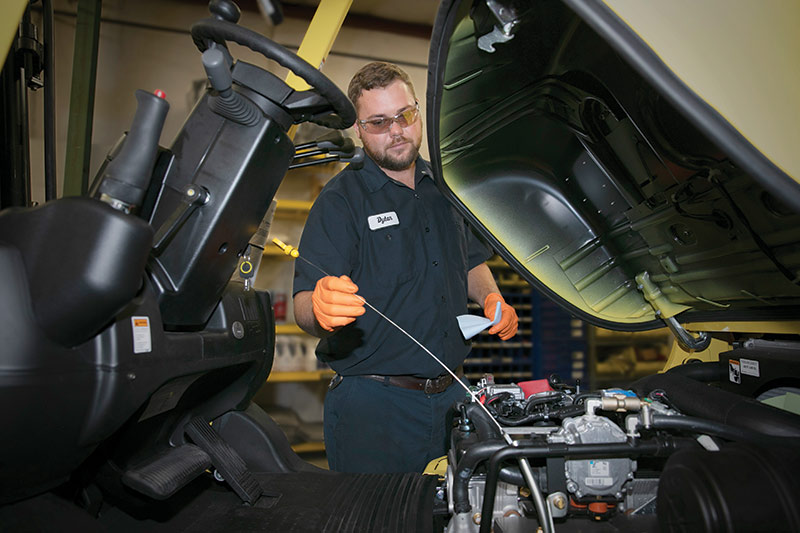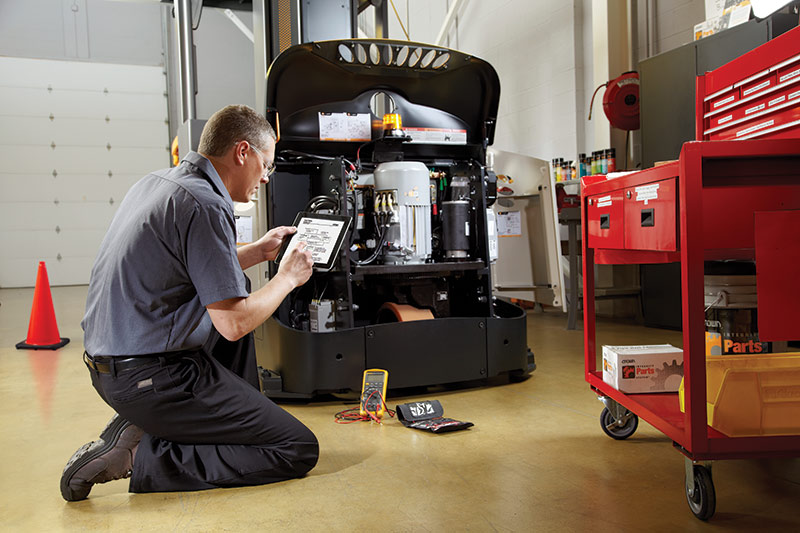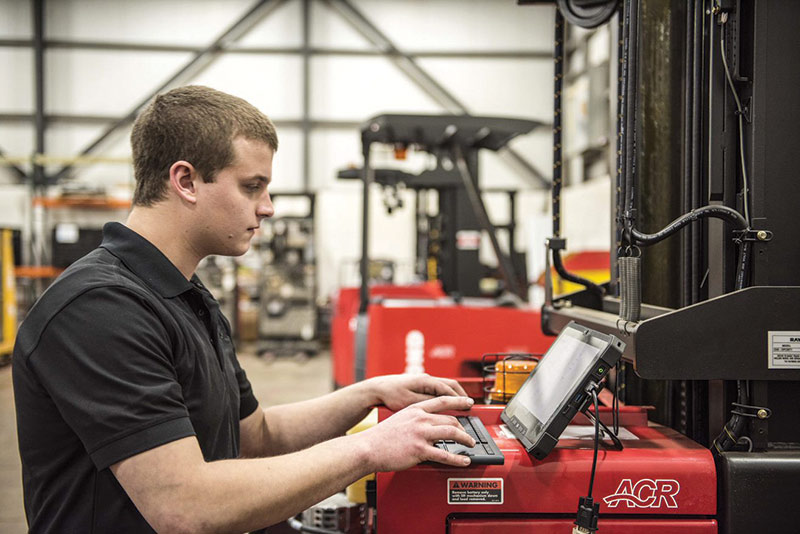The power of lift truck maintenance
With lead times for new lift trucks out as much as 100 weeks, maintenance has taken on new importance. Fortunately, suppliers and dealers alike have some powerful tools that provide a more proactive approach to service at both the fleet and individual truck level.
You need to take into consideration two views on lift truck maintenance. One is macro and the other is micro.
At the macro level, it’s all about managing the life expectancy of your lift trucks as a fleet. Yes, the entire fleet. Even across five or 10 locations for a single company. This is a big, broad concept used at certain leading companies, and is, by no means, a standard procedure most places. But there’s nothing that says this can’t be the future.
At the micro level, it’s all about managing the operational health of each truck in your fleet on an individual basis. And that’s all the way down to how batteries are managed. This has long been the maintenance sweet spot for trucks.
Believe it or not, the two are not in competition with each other. In fact, they are complementary. While it does make the lift truck maintenance equation a bit more difficult to solve, another condition has put a new emphasis on maintenance.
New lift truck lead times right now are as much as 100 weeks. Clearly, we are not in a time of wish and replace. That requires elevated maintenance planning and execution on your part.
Fortunately, lift truck suppliers and dealers have given this more than just a passing thought and have some valuable insights to make maintenance programs effective for you. Here are some of the latest thoughts from these experts.
Managing the fleet
Let’s start with the big picture premise here. “A lift truck fleet needs to be managed broadly. Not even facility by facility, but as a complete fleet, regardless of its size,” says Tim Roth, Crown Equipment’s director of branch aftermarket operations.

When Roth talks of the complete fleet, he really does mean all of it from rentals to trucks that have been out on the floor long enough that they don’t owe anyone anything. While each of these trucks has its own hourly cost, the key number here is the overall hourly cost for the full fleet.
Kris Rendtorff, fleet analytics supervisor at Associated, a Raymond dealer in Chicagoland, breaks those costs down this way. “It’s all about the cost to operate each truck for one hour. As an example, in its first year of use, a lift truck could well cost just $1/hour to operate. But by the time the truck is 10 years into its service life, that number is probably a lot closer to $5/hour.”
In turn, at any point in time, there is an average cost per hour to run the entire fleet. That compares, says Rendtorff, to your pre-determined acceptable hourly cost for the fleet. He calls that your economic life expectancy.
Ideally, none of this came up this morning. Instead, you’ve been tracking both fleet and individual truck maintenance (details on this later) for some time. You already know the profile of your fleet and have a breakdown of it by truck type, application and ownership (rental, lease, owned).
Enter your rotation strategy. Quite simply, it’s now time to go micro and determine which trucks need to be rotated out of the fleet at a specific point in time without sacrificing operational performance out on the floor. This is critical.
“How trucks are used has changed from being an occasional tool to an integrated part of key processes,” says Ken Deters, Hyster’s director of service operations.
The performance of all trucks (including the debut of more autonomous lift trucks) directly impacts the flow of goods within the four walls. Deters says this requires sophistication on your part to offset the needs of first the fleet and then of individual trucks against the needs of the facility to handle and move product.
It’s also worth repeating that lift truck lead times add still another wild card to this decision tree. However, this rotation process is clearly an effective way to manage your fleet.
Roth tells the story of one large lift truck user that is making a run at the macro approach to lift truck maintenance. While the company is in the early stages of a pilot at one facility, it is already seeing the benefits of a more proactive approach to service in terms of improved uptime, and what Roth calls an elevated overall health of trucks. The company is now in the process of rolling it out from its pilot facility to a second one.

Managing each truck
It’s now time to drill down to lift truck maintenance at the individual vehicle level.
“Lift trucks are the workhorses of any materials handling site. They need to be well-maintained to stay in good condition,” says Henry Glover, service engineering and warranty manager at Mitsubishi Logisnext Americas.
And while some operations still follow the don’t-fix-it-until-it-breaks philosophy, most have in place at least a semi-formalized maintenance program. Several approaches are at work here.
If having a workforce of in-house maintenance techs isn’t practical, both dealers and lift truck suppliers often have their own tech workforce available for contract. For instance, Rendtorff says Associated has more than 300 techs for the seven states it serves. Crown has thousands of service techs in the United States that work with a similar number of techs in its dealer network. Hyster provides tools, technology and ongoing training to the more than 5,000 service techs throughout its network of North American dealers that provide local maintenance.
Maintenance contracts from both suppliers and dealers are offered with a range of options to eliminate what you must do in house. They range from comprehensive fixed-price maintenance programs that may include resident, on-site techs to emergency breakdown repair programs complete with access to techs on demand.
The move to planned maintenance
Whatever the program, the overriding theme is to move from periodic to planned maintenance. And there is no understating the importance of that move, says Deters.
Building maintenance plans, says Rendtorff, requires precise tracking of the tasks each truck performs, its application and usage levels and maintenance history, to name four key parameters. And far beyond simply keeping trucks up and running, planned maintenance is central to the rotation strategy mentioned earlier.
By the way, this should be carried all the way down to details about batteries. After all, who wants to have more than one battery per truck? Great idea, but that requires advanced maintenance scheduling to make it a reality.
The keyword in tracking individual lift truck activity and performance is telemetry. And the secret sauce of telemetry is data. And that data is, increasingly, what makes the lift truck maintenance world go ‘round.
While not universally used on lift trucks, telemetry is the baseline system for most. These onboard systems collect all relevant data about the truck as it moves around the facility. The collected data is typically sent to the Cloud and a database built about that specific truck.
The benefit, says Deters of Hyster, is a lower total cost of ownership for that truck due to optimizations that enable monitoring of activities and timely maintenance. “This is valuable and actionable data that’s easy for the user to digest and make better decisions regarding truck use and repair,” Deters adds.
Timely maintenance. That’s increasingly essential today. Fortunately, suppliers have several systems that make that timeliness possible.
For instance, Crown offers its InfoLink operator and fleet management system. Roth says it captures lift truck data in real time and can help expedite service. Roth mentions that the system is key to the company’s proactive dispatch service to help increase overall uptime.
Hyster’s offering here is called Hyster Tracker for the entire truck. Hyster, says Deters, also offers Hyster Battery Tracker. It monitors usage, and alerts maintenance to possible battery issues. In addition, the system manages maintenance responses with the intent of extending performance and life. It can also be used to schedule battery maintenance to have the least impact on scheduled lift truck usage.
Rendtorff says Raymond’s iWarehouse is a Web-based portal that manages telemetry data direct from individual trucks. A related program, iTrack, manages assets and their maintenance. Yet another program, Power BI from Microsoft is a powerful tool for extrapolating and analyzing lift truck data that can impact maintenance decisions, says Rendtorff.
What about the techs
One last thought about the state of lift truck maintenance today: Don’t forget about the techs themselves. No doubt, most any company with a lift truck tech workforce would like to see more candidates and more techs on staff. And that will continue to be a struggle, say the experts.
But regardless of staffing levels, the role of the tech is expanding. There is still a strong element of wrench turning. But as the technology that identifies maintenance issues becomes more electronic, that also requires techs to have additional analytical and technology skills to keep pace. In addition, techs today are also on-site consultants with an expertise beyond standard maintenance tasks.
To get all this done, lift truck techs are being trained differently. Gone are the days of riding with a mentor for two or three years. Now, it’s a combination of high-intensity, short-burst classroom training that teaches techs in bite size units then moves them over to hands-on training for immediate reinforcement. Needless to say, the learning curve can be steep.
In the end, the impact is expected to be positive, resulting in longer term career paths with more interesting challenges along the way.
Clearly, lift truck maintenance has taken on a new urgency across distribution and manufacturing. And with the help of increasingly sophisticated tools and practices, the value proposition for trucks continues to climb.

Article Topics
MRO News & Resources
Learn from lift truck service history Avidbots showcases autonomous cleaning robots Traka exhibits modular lockers MRO Survey: Finding and keeping the best technicians 60 Seconds with Jordan Taft, Welder at Raymond Corporation Maintenance, Repair and Operations: Understanding the true condition of the equipment Predictive maintenance: Ready to launch More MROLatest in Materials Handling
Geek+ and System Teknik deploy PopPick solution for pharmacy group Med24.dk Beckhoff USA opens new office in Austin, Texas Manhattan Associates selects TeamViewer as partner for warehouse vision picking ASME Foundation wins grant for technical workforce development The (Not So) Secret Weapons: How Key Cabinets and Asset Management Lockers Are Changing Supply Chain Operations MODEX C-Suite Interview with Harold Vanasse: The perfect blend of automation and sustainability Consultant and industry leader John M. Hill passes on at age 86 More Materials HandlingAbout the Author
Subscribe to Materials Handling Magazine

Find out what the world's most innovative companies are doing to improve productivity in their plants and distribution centers.
Start your FREE subscription today.
April 2024 Modern Materials Handling

Latest Resources












